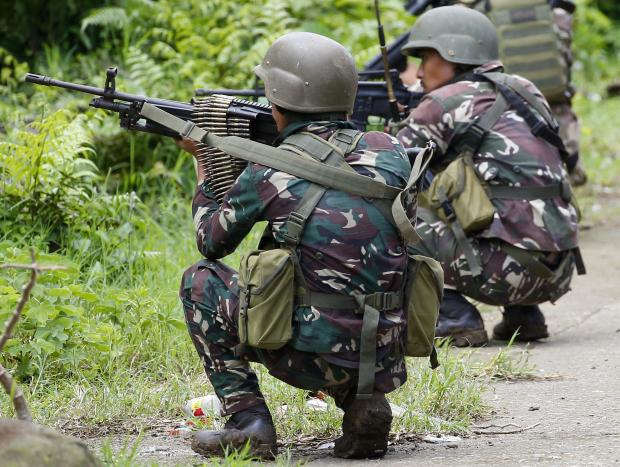AFP chief: Marawi City siege was start of extremist plan

Government troops take positions as fighting with Muslim militants in Marawi City enters its second week Tuesday, May 30, 2017, in Mindanao. Philippine forces pressed their offensive to drive out militants linked to the Islamic State group after days of fighting left corpses in the streets and hundreds of civilians begging for rescue. (Photo by BULLIT MARQUEZ / AP)
MARAWI, Lanao del Sur — Militants who occupied much of Marawi City over the past week were planning violent attacks during the holy month of Ramadan to earn recognition as a regional branch of the Islamic State group, Gen. Eduardo Año, chief of the Armed Forces of the Philippines (AFP), said Tuesday.
Soldiers have taken control of about 70 percent of Marawi, where the gunmen have been fending off the army for a week, Año said. About 100 militants, troops and civilians have been killed.
“They wanted to show the world that there is an ISIS branch here which can inflict the kind of violence that has been seen in Syria and Iraq,” Año told The Associated Press, using an acronym for the Islamic State group.
The siege in Marawi followed an unsuccessful Army raid that attempted to capture militant commander Isnilon Hapilon, who has been designated by the Islamic State group as its leader in the Philippines.
Hapilon escaped and gunmen loyal to him besieged this mostly Muslim city of 200,000 people, torching buildings and taking hostages. Año said the gunmen were prepared to fight because of their Ramadan attack plot.
Article continues after this advertisementThe unrest has boosted fears that the Islamic State group’s violent ideology is gaining a foothold in the Philippines’ restive southern islands, where a Muslim separatist rebellion has raged for decades.
Article continues after this advertisementPresident Rodrigo Duterte declared martial law in Mindanao through mid-July, but lawmakers on Tuesday asked for a public session of Congress to determine whether martial law would still be necessary.
Duterte’s declaration unnerved Filipinos who had lived through the rule of late dictator Ferdinand Marcos, who declared martial law in 1972 and used it to hold power for more than a decade.
The AFP insists the drawn-out fight in Marawi is not a true sign of the militants’ strength, and that the military has held back to spare civilians’ lives.
As of Tuesday morning, Año said the military, working house-by-house, had cleared 70 percent of the city and the remaining militants were isolated.
Still, the fighters have turned out to be remarkably well-armed and resilient.
In recent years, small militant groups in the Philippines, Indonesia and Malaysia have begun unifying under the banner of the Islamic State group. Solicitor General Jose Calida said last week that the violence on Mindanao “is no longer a rebellion of Filipino citizens.”
Three Malaysians, an Indonesian and possibly Arab extremists have been killed in the Marawi fighting, Año said, citing the latest intelligence on the matter. He said Hapilon was still hiding somewhere in the city and that authorities were working to confirm another top militant had been killed.
At least 65 militants have been killed and 15 Philippine troops, Año said. The bodies of 19 civilians have been recovered and local authorities have reported more civilian deaths still to be tallied.
Rohan Gunaratna, a terrorism expert at Singapore’s S. Rarajatnam School of International Studies, said the fighting in Marawi, along with smaller battles elsewhere in Mindanao, may be precursors to declaring a province, which would be “a huge success for the terrorists.”
Last week, two suicide bombings in Jakarta, Indonesia, killed three police officers, an attack claimed by IS. While Indonesia has been fighting local militants since 2002, the rise of the Islamic State group has breathed new life into those militant networks and raised concern about the risk of Indonesian fighters returning home from the Middle East.
Experts have warned that as IS is weakened in Syria and Iraq, battered by years of American-led attacks, Mindanao could become a focal point for regional fighters.
Southeast Asian fighters fleeing the Middle East “could look to Mindanao to provide temporary refuge as they work their way home,” said a report late last year by the Jakarta-based Institute for Policy Analysis of Conflict, predicting a high risk of regional violence. Marawi is regarded as the heartland of the Islamic faith on Mindanao island.
Año told The Associated Press on Tuesday that the extremists had plotted to set Marawi ablaze entirely to project the influence of the Islamic State. The extremists wanted to kill Christians in nearby Iligan City on Ramadan, the Muslim holy month of fasting, to mimic the violence seen by the world in Syria and Iraq, Año said.
The fighters’ support network in Marawi remains unclear, though the power of one militant group – the Mautes – has grown in recent years. Led by members of the city’s Maute clan, the group has become increasingly active in a number of towns across Lanao del Sur province, where Marawi is located, and has been instrumental in the fighting this past week.
Muslim rebels have been waging a separatist rebellion in the south of the predominantly Roman Catholic nation for decades. The largest armed group dropped its secessionist demands in 1996, when it signed a Muslim autonomy deal with the Philippine government. Amid continuing poverty and other social ills, restiveness among minority Muslims has continued.
Hapilon is an Islamic preacher and former commander of the Abu Sayyaf militant group who pledged allegiance to the Islamic State group in 2014. He now heads an alliance of at least 10 smaller militant groups, including the Maute./rga